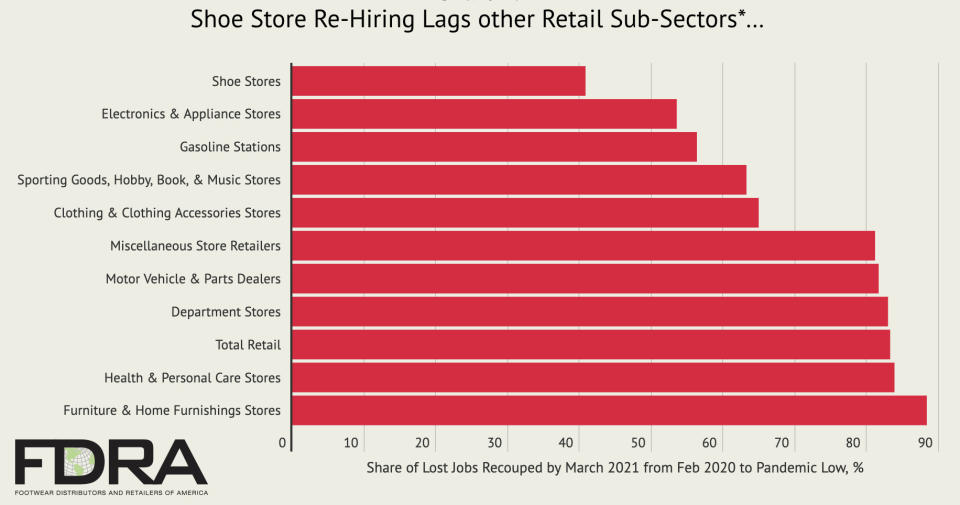Shoe Store Hiring Is Lagging Other Retail Sectors: Here Are 3 Reasons Why

The footwear sector is struggling to hire workers — and new data suggests that their recovery could remain slow in the year ahead.
According to the Footwear Distributors and Retailers of America, which recently released its economic and employment data for the month of March, shoe stores have recouped only two-fifths, or 40.8%, of the jobs lost during the coronavirus health crisis. That marks the lowest yield in new workers than any other sub-sector in retail, including clothing and accessories stores, department stores and miscellaneous store retailers.
More from Footwear News
Amazon Is Raising Wages for 500,000 Workers -- Here's Why That Matters
Dollar General Plans to Hire as Many as 20,000 New Staffers in These Roles

In its analysis, the trade group found three key factors that could be constraining hiring in footwear stores: One, some types of retailers have hiked their pay and benefits in an attempt to attract and retain workers — perhaps as well as incentivize them to return to work amid the pandemic. Last month, for instance, average hourly wages paid across retail increased to a record high in April at $21.75 per hour. Shoe stores’ hourly pay, on the other hand, have remained “little changed” over recent months.
Another reason behind the lag could be the government’s unemployment benefits, which were doled out to millions as part of broader COVID-19 relief packages. The weekly additional pay, according to some employers, could have disincentivized lower-paid workers from returning to the labor force, which has limited the pool of available and interested employees for hire.
“I don’t blame individuals [for not working]. It’s just a function of what we have going on right now,” said Jeffrey Seidman, owner of Ahh Comfort Shoes in Arlington Heights. “If you’re making somewhere between $15 and $20 an hour, and you’re going to be able to stay at home and have $15 an hour, I get it. I really do. Who wouldn’t rather stay home than go to work?”
What’s more, shoe store sales are said to still be “soft” compared to several of their sub-sector counterparts, which have posted year-over-year rebounds. The FDRA implied that this could mean “less immediate need” for workers as consumers spend at other higher-demand retailers like health and personal care or home furnishing stores.
“On balance, while we continue to expect shoe store sales will rebound appreciably in coming months against weak year-ago comps, we remain downbeat on prospects for the number of workers in shoe stores to recover as impressively,” added the organization.
Late last week, the Bureau of Labor Statistics reported a disappointing 266,000 new jobs in April, with the unemployment rate holding steady at 6.1%. The results were a far cry from economists’ estimates of a million new jobs and unemployment rate of 5.8%. The agency recorded notable gains in leisure and hospitality, partially offset by declines in temporary help services and in couriers or messengers.
“April’s jobs report shows progress toward getting back to pre-pandemic levels of employment but underscores the continued need for additional targeted relief for small businesses,” added International Council of Shopping Centers spokesperson Stephanie Cegielski. “As vaccine rollout continues and more businesses are able to operate at full or near-full capacity, we expect hiring to pick up significantly over the summer. We are confident the economy remains on a strong trajectory, and other indicators — including retail sales and consumer confidence — suggest these predictions will come true.”
This story was updated with a statement from the International Council of Shopping Centers.
—With contributions from Jennie Bell
Sign up for FN's Newsletter. For the latest news, follow us on Facebook, Twitter, and Instagram.

